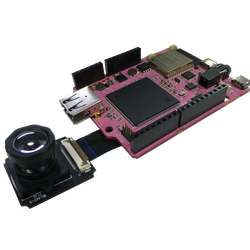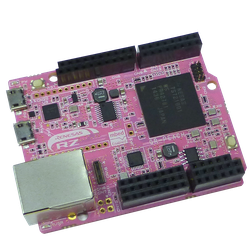Generic Pelion Device Management example for various Renesas-based boards.
DEPRECATED
This example application is not maintained and not recommended. It uses an old version of Mbed OS, Pelion DM, and Arm toolchain. It doesn't work with Mbed Studio.
Please use: https://os.mbed.com/teams/mbed-os-examples/code/mbed-os-example-pelion/
This example is known to work great on the following platforms:
- Renesas GR-LYCHEE over Wi-Fi and using SD card.
- Renesas GR-PEACH over Ethernet and using SD card.


Follow the Quick-Start instructions: https://cloud.mbed.com/quick-start
Example functionality
This example showcases the following device functionality:
- On user button click, increment Pelion LWM2M button resource.
- Allow the user to change the state of the board LED from Pelion LWM2M led_state resource and PUT request.
Instructions to use this program with Mbed CLI
1. Import the application into your desktop:
mbed import https://os.mbed.com/teams/Renesas/code/pelion-example-common cd pelion-example-common
2. Install the CLOUD_SDK_API_KEY
mbed config -G CLOUD_SDK_API_KEY <PELION_DM_API_KEY>
For instructions on how to generate your API key, please see the documentation.
3. Initialize firmware credentials (done once per repository). You can use the following command:
mbed dm init -d "<your company name in Pelion DM>" --model-name "<product model identifier>" -q --force
If above command do not work for your Mbed CLI, please consider upgrading Mbed CLI to version 1.8.x or above.
4. Compile and program:
mbed compile -t <toolchain> -m <TARGET_BOARD>
(supported toolchains : GCC_ARM / ARM / IAR)
Note
This platform and application is suitable for evaluation and initial development. For production purposes, we recommend to use a different variant with built-in security features - for more information please contact Renesas (https://en-support.renesas.com/mytickets)
main.cpp
- Committer:
- MACRUM
- Date:
- 2018-12-15
- Revision:
- 0:6d2053b84a92
- Child:
- 4:6061130e9a4f
File content as of revision 0:6d2053b84a92:
// ----------------------------------------------------------------------------
// Copyright 2016-2018 ARM Ltd.
//
// SPDX-License-Identifier: Apache-2.0
//
// Licensed under the Apache License, Version 2.0 (the "License");
// you may not use this file except in compliance with the License.
// You may obtain a copy of the License at
//
// http://www.apache.org/licenses/LICENSE-2.0
//
// Unless required by applicable law or agreed to in writing, software
// distributed under the License is distributed on an "AS IS" BASIS,
// WITHOUT WARRANTIES OR CONDITIONS OF ANY KIND, either express or implied.
// See the License for the specific language governing permissions and
// limitations under the License.
// ----------------------------------------------------------------------------
#ifndef MBED_TEST_MODE
#include "mbed.h"
#include "simple-mbed-cloud-client.h"
#include "FATFileSystem.h"
// An event queue is a very useful structure to debounce information between contexts (e.g. ISR and normal threads)
// This is great because things such as network operations are illegal in ISR, so updating a resource in a button's fall() function is not allowed
EventQueue eventQueue;
// Default block device
BlockDevice *bd = BlockDevice::get_default_instance();
FATFileSystem fs("fs");
// Default network interface object
NetworkInterface *net = NetworkInterface::get_default_instance();
InterruptIn btn(USER_BUTTON0);
// Declaring pointers for access to Pelion Device Management Client resources outside of main()
MbedCloudClientResource *button_res;
MbedCloudClientResource *pattern_res;
void button_press() {
int v = button_res->get_value_int() + 1;
button_res->set_value(v);
printf("User button clicked %d times\n", v);
}
/**
* PUT handler
* @param resource The resource that triggered the callback
* @param newValue Updated value for the resource
*/
void pattern_updated(MbedCloudClientResource *resource, m2m::String newValue) {
printf("PUT received, new value: %s\n", newValue.c_str());
}
/**
* POST handler
* @param resource The resource that triggered the callback
* @param buffer If a body was passed to the POST function, this contains the data.
* Note that the buffer is deallocated after leaving this function, so copy it if you need it longer.
* @param size Size of the body
*/
void blink_callback(MbedCloudClientResource *resource, const uint8_t *buffer, uint16_t size) {
printf("POST received. Going to blink LED pattern: %s\n", pattern_res->get_value().c_str());
static DigitalOut augmentedLed(LED1); // LED that is used for blinking the pattern
// Parse the pattern string, and toggle the LED in that pattern
string s = std::string(pattern_res->get_value().c_str());
size_t i = 0;
size_t pos = s.find(':');
while (pos != string::npos) {
wait_ms(atoi(s.substr(i, pos - i).c_str()));
augmentedLed = !augmentedLed;
i = ++pos;
pos = s.find(':', pos);
if (pos == string::npos) {
wait_ms(atoi(s.substr(i, s.length()).c_str()));
augmentedLed = !augmentedLed;
}
}
}
/**
* Notification callback handler
* @param resource The resource that triggered the callback
* @param status The delivery status of the notification
*/
void button_callback(MbedCloudClientResource *resource, const NoticationDeliveryStatus status) {
printf("Button notification, status %s (%d)\n", MbedCloudClientResource::delivery_status_to_string(status), status);
}
/**
* Registration callback handler
* @param endpoint Information about the registered endpoint such as the name (so you can find it back in portal)
*/
void registered(const ConnectorClientEndpointInfo *endpoint) {
printf("Connected to Pelion Device Management. Endpoint Name: %s\n", endpoint->internal_endpoint_name.c_str());
}
int main(void) {
printf("Starting Simple Pelion Device Management Client example\n");
printf("Connecting to the network...\n");
// Connect to the internet (DHCP is expected to be on)
nsapi_error_t status = net->connect();
if (status != NSAPI_ERROR_OK) {
printf("Connecting to the network failed %d!\n", status);
return -1;
}
printf("Connected to the network successfully. IP address: %s\n", net->get_ip_address());
// SimpleMbedCloudClient handles registering over LwM2M to Pelion Device Management
SimpleMbedCloudClient client(net, bd, &fs);
int client_status = client.init();
if (client_status != 0) {
printf("Pelion Client initialization failed (%d)\n", client_status);
return -1;
}
// Creating resources, which can be written or read from the cloud
button_res = client.create_resource("3200/0/5501", "button_count");
button_res->set_value(0);
button_res->methods(M2MMethod::GET);
button_res->observable(true);
button_res->attach_notification_callback(button_callback);
pattern_res = client.create_resource("3201/0/5853", "blink_pattern");
pattern_res->set_value("500:500:500:500:500:500:500:500");
pattern_res->methods(M2MMethod::GET | M2MMethod::PUT);
pattern_res->attach_put_callback(pattern_updated);
MbedCloudClientResource *blink_res = client.create_resource("3201/0/5850", "blink_action");
blink_res->methods(M2MMethod::POST);
blink_res->attach_post_callback(blink_callback);
printf("Initialized Pelion Client. Registering...\n");
// Callback that fires when registering is complete
client.on_registered(®istered);
// Register with Pelion Device Management
client.register_and_connect();
// Setup the button
btn.mode(PullUp);
// The button fall handler is placed in the event queue so it will run in
// thread context instead of ISR context, which allows safely updating the cloud resource
btn.fall(eventQueue.event(&button_press));
// You can easily run the eventQueue in a separate thread if required
eventQueue.dispatch_forever();
}
#endif